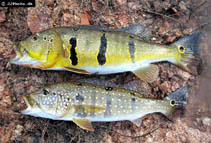| Diagnosis: |
Diagnosis: This species is most similar to its congeners jariina, temensis, thyrorus, and vazzoleri in having four or more horizontal rows of light spots along side in subadults and large females, and prominent black, light-margined vertical bars or blotches in adults. It differs in having an ocellated dark blotch dorsally in bar 3 (vs. absent in temensis, absent or present only in the breeding pattern together with other ocellated blotches in thyrorus and vazzoleri. Scales in E1 row 86-105 (vs. 77-90 in thyrorus). Lateral line commonly not continuous (vs. usually continuous in temensis and thyrorus. Differs from C. temensis in having less scales in E1 row, 86-105, usually less than 100 (vs. 98-128), usually more than 110, and vertical bars of adults blotch-like and bar 1 often appearing as round blotch or divided into 2-3 blotches, instead of straight vertical and about uniformly wide. Differs from C. vazzoleri
by having larger scales (86-105 vs. 95-114), but ranges overlap, and common absence of row of light spots along the abdominal side (vs. persistent in vazzoleri). Breeding individuals possess three ocellated bars, which is continuous above upper lateral line when extending above it, and isolated blotches on dorsum usually not present (vs. dorsal blotches present or absent in vazzoleri, and typically three vertical rows of 3, 3, and 2 blotches in jariina and thyrorus) (Ref. 57716). |

